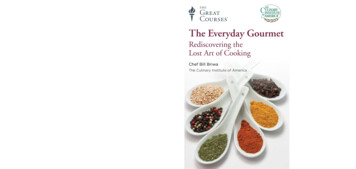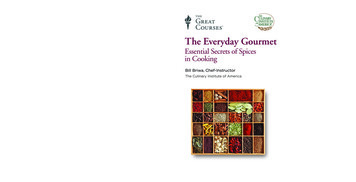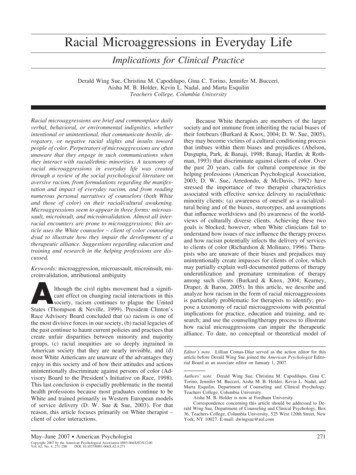
Transcription
Notable alumni include Anthony Bourdain,chef, author, and television personality;Anne Burrell, from Food Network’s Secretsof a Restaurant Chef; and Cat Cora, fromFood Network’s Iron Chef America.The Everyday Gourmet: Rediscovering theLost Art of Cooking was filmed on locationat the CIA’s campus at Greystone inCalifornia’s Napa Valley.A unique collaboration The Great Courses, leaders in lifelong learning “Pure intellectual stimulation that can be popped into the[audio or video] player anytime.”—Harvard Magazine “Passionate, erudite, living legend lecturers.Academia’s best lecturers are being captured on tape.”—The Los Angeles Times“A serious force in American education.”—The Wall Street Journalpartners with The Culinary Institute of America, leaders in culinary education “The CIA has been setting the standard for excellence in professionalculinary education for more than 60 years.”—Martha Stewart, entrepreneur and domestic lifestyle innovator “ [A]n institution that has truly changed the way the world looksat food.” —Anthony Terlato, chairman of Terlato Wine Groupand Wine Enthusiast’s Man of the Year in 2003“It’s the best culinary school in the world.”—Paul Bocuse, world-renowned French chefChef Bill Briwa is a Chef-Instructor at The Culinary Instituteof America at Greystone, where he has developed curriculaand has taught cooking, flavor dynamics, gastronomy, andfood-and-wine pairing for the past 15 years. A CertifiedExecutive Chef and Certified Hospitality Educator, ChefBriwa has worked extensively in the hospitality industryand has owned and operated his own bistro. He has been aspeaker at many professional conferences, and his writingon food and wine, olive oil, and cooking has been featuredin Fine Cooking, Mise en Place, and Sunset magazines.THE GREAT COURSES Corporate Headquarters4840 Westfields Boulevard, Suite 500Chantilly, VA 20151-2299USAPhone: 1-800-832-2412www.thegreatcourses.comThe Everyday GourmetRediscovering theLost Art of CookingChef Bill BriwaThe Culinary Institute of AmericaDoes the question “What’s for dinner?”haunt you on a daily basis, or do you lovespending time preparing a meal for yourfamily? Regardless of your level of comfortwith cooking, this course, taught by anexpert Chef-Instructor at The CulinaryInstitute of America, is designed to boostyour confidence in the kitchen and help youcreate meals that you are proud to share.In 24 comprehensive lessons, you willexpand your knowledge of the basics ofcooking and delve into some freshtactics that are sure to spark your interest.Along the way, you will learn helpful tipsand secrets of the trade that you will wantto test. This course focuses on techniquesrather than recipes so that your newfoundknowledge about cooking can betransferred to other dishes that you try athome. Throughout the process of cooking,you are encouraged to taste your creations,adjust the seasonings, and vary theingredients according to what you have onhand. The idea is to play with the flavorson your palate so that you truly understandwhat goes into successful cooking.Throughout the course, you will learnmethods for preparing ingredients andhandling equipment, adding flavor and spiceto everyday meals, and creating classic andcontemporary dishes. By the end of thiscourse, you will know when and how touse the four essential cooking techniques:dry-heat cooking with fat, dry-heat cookingwithout fat, moist-heat cooking, andcombination cooking. With The EverydayGourmet: Rediscovering the Lost Art ofCooking, you will learn how to make newand interesting main dishes, sides thatdon’t sit on the sidelines, and tantalizingdesserts—dishes that you can serve with atriumphant “ta-da!”Look for our baking, healthy cooking,and other Great Courses related to foodand wine at www.thegreatcourses.com.Cover Images: iStockphoto/Thinkstock. Marcy McDonald.Course No. 9231 2012 The Teaching Company.The Everyday Gourmet: Rediscovering the Lost Art of CookingThe Everyday Gourmet: Rediscovering theLost Art of Cooking is taught by Chef BillBriwa, Certified Executive Chef, CertifiedHospitality Educator, and Chef-Instructor atThe Culinary Institute of America (CIA), theworld’s premier culinary college. Foundedin 1946 as a school to train returning WorldWar II veterans in the culinary arts, the CIAhas grown from its original enrollment of50 students and three faculty members toinclude more than 2,800 undergraduatestudents, more than 140 chefs andinstructors, and four campuses. TheInstitute also offers continuing educationprograms for food service professionals,wine professionals, and food enthusiasts;publishes textbooks and cookbooks;operates nine student-staffed restaurants;and hosts the Worlds of Flavor Conferenceand Festival.OI9231A
PUBLISHED BY:THE GREAT COURSESCorporate Headquarters4840 Westfields Boulevard, Suite 500Chantilly, Virginia 20151-2299Phone: 1-800-832-2412Fax: 703-378-3819www.thegreatcourses.comCopyright The Teaching Company, 2012Printed in the United States of AmericaThis book is in copyright. All rights reserved.Without limiting the rights under copyright reserved above,no part of this publication may be reproduced, stored inor introduced into a retrieval system, or transmitted,in any form, or by any means(electronic, mechanical, photocopying, recording, or otherwise),without the prior written permission ofThe Teaching Company.
Bill Briwa, C.E.C., C.H.E.Chef-InstructorThe Culinary Institute of Americaat GreystoneA1980 graduate of The CulinaryInstitute of America (CIA), Chef BillBriwa has worked in the hospitalityindustry for over 30 years and is a CertifiedExecutive Chef and Certified HospitalityEducator. In addition to being the resident cheffor The Hess Collection winery in California’sNapa Valley, Chef Briwa owned and operatedhis own bistro and worked at Thomas Keller’saward-winning restaurant The French Laundry. He was also the executive cheffor The Wine Spectator Restaurant at The CIA at Greystone and served as anofficer on the board of the St. Helena Farmers’ Market. As culinary chair ofthe 2004 Napa Valley Wine Auction, Chef Briwa helped raise more than fivemillion dollars for local charities. In addition to his work as a cook and chef,he has worked as both a baker and pastry chef. His writing on food and wine,olive oil, and cooking has been featured locally and in Fine Cooking, Mise enPlace, and Sunset as well as in the trade publications Flavor & the Menu andPractical Winery & Vineyard Journal.As a Chef-Instructor at the CIA, Chef Briwa has developed curricula and hastaught cooking, flavor dynamics, gastronomy, and food-and-wine pairing fulltime for the past 15 years. He has traveled to both teach and study cookingacross the United States and to China, Mexico, South and Central America,Europe, and around the Mediterranean. In addition, he is partof the Industry Services Group at the CIA and works closelywith a broad range of corporate clients to help themrealize their culinary goals.Chef Briwa has been a speaker at manyprofessional conferences, and he takes partin the Healthy Kitchens, Healthy Livesconference held twice each year at TheCIA at Greystone. The conference iscopresented by Harvard School ofPublic Health and the CIA. ChefBriwa has collaborated withi
Dr. Connie Guttersen, an instructor at the CIA and author of The Sonoma Diet,on numerous presentations on nutrition and cooking, including a course onthe science of healthy cooking produced by The Great Courses. In 2003, ChefBriwa was a judge for the American Cheese Society, and in 2005, he presentedon gastronomy at the annual conference of the International Associationof Culinary Professionals (IACP). In 2005, 2006, and 2007, he presented atthe International Foodservice Manufacturers Association’s (IFMA) ChainOperators Exchange (COEX) conference, and in 2008 and 2009, he spoke atthe National Restaurant Association (NRA) Show in Chicago, Illinois. ChefBriwa also presented at Beyond Extra Virgin IV, a conference on superpremiumolive oil, in Verona, Italy.Over the last 30 years of cooking and teaching, Chef Briwa has taken one shortbreak from the stove to become a puppeteer. He lives in Yountville, California,with his wife and a border collie—both of whom think highly of his cooking. ii
iii
Table of ContentsLESSON GUIDESLesson 1Cooking—Ingredients, Technique, and Flavor 1Lesson 2Your Most Essential Tool—Knives 7Lesson 3More Essential Tools—From Pots to Shears 16Lesson 4Sauté—Dry-Heat Cooking with Fat 25Lesson 5Roasting—Dry-Heat Cooking without Fat 32Lesson 6Frying—Dry-Heat Cooking with Fat 39Lesson 7From Poach to Steam—Moist-Heat Cooking 46Lesson 8Braising and Stewing—Combination Cooking 53Lesson 9Grilling and Broiling—Dry-Heat Cooking without Fat 60Lesson 10Stocks and Broths—The Foundation 67Lesson 11The Stir-Fry Dance—Dry-Heat Cooking with Fat 76Lesson 12Herbs and Spices—Flavor on Demand 83Lesson 13Sauces—From Beurre Blanc to Béchamel 94Lesson 14Grains and Legumes—Cooking for Great Flavor 103iv
Table of ContentsLesson 15Salads from the Cold Kitchen 111Lesson 16Eggs—From the Classic to the Contemporary 119Lesson 17Soups from around the World 128Lesson 18From Fettuccine to Orecchiette—Fresh and Dry Pastas 137Lesson 19Meat—From Spatchcocked Chicken to Brined Pork Chops 146Lesson 20Seafood—From Market to Plate 155Lesson 21Vegetables in Glorious Variety 163Lesson 22A Few Great Desserts for Grown-Ups 170Lesson 23Thirst—The New Frontier of Flavor 177Lesson 24Crafting a Meal, Engaging the Senses 185SUPPLEMENTAL MATERIALRecipe List 193Bibliography 195Photographic Credits 197v
This course focuses on cooking techniques, ingredients, and flavor.Shopping lists for ingredients are included, but the proportions will beup to you! Our Chef-Instructor encourages you to taste and experimentto become a more confident and competent cook.
Cooking—Ingredients, Technique,and FlavorOLesson 1ver the course of the following 24 lessons, you will learn foundationalcooking techniques that will open up a broader world of food andcooking for your enjoyment. The goal of this comprehensive programis to help you become a better cook—one that is more confident, moreaware, and more likely to draw satisfaction from the craft of preparing food.This program is based on three broad themes. The first is understanding thatingredients have to be of good quality and that you can only expect thoseingredients to do certain things. The second broad theme is learning somefoundational cooking techniques. Finally, it is important that you understandthe interaction of taste and flavor, which is the focus of this lesson.The Interaction of Taste and FlavorAll human beings have an opening—our mouth—through which every bit ofthe food that we eat passes. Our mouth is artificially moistened with saliva,and the moisture of saliva facilitates swallowing. Saliva also has antimicrobialproperties that protect us. Furthermore, we can’t taste unless the things that weare eating begin to dissolve, and the enzymes in saliva break down food.Our mouth has taste buds on our tongue and palate, and those taste buds havethe ability to perceive the five basic tastes: sweet, sour, salty, bitter, and savory.The five basic tastes are meaningful. They are markers for things that haveassured our survival since the beginning of mankind.Sweetness is a marker for ripeness in fruits and vegetables. When we tastesweetness, which we are predisposed to like, we respond positively. Whensweetness is available to us, such as when we encounter a bush of riperaspberries, we are encouraged to fill our bodies with carbohydrates, whichprovide energy for our existence.Saltiness is a marker for sodium, which we need to regulate our bodilyfunctions, but it is also a marker for micronutrients and minerals.Sourness is a marker for underripeness—or even spoilage. Sourness is awarning signal that alerts us to stop eating a certain food. This mechanism iswhat keeps us from eating too many green apples and getting a stomachache.1
Bitterness is a marker for alkaloids. In a plant-based diet, alkaloids are oftenpoisonous. Bitterness warns us that we are eating a food that might be risky to eat.Savory flavors are the most difficult to describe and to understand. Savoriness,or what the Japanese call umami, is the flavor of protein that has begun to breakdown a little bit through enzyme activity or through long cooking. Savoryflavors can be found in soy sauce, cured meats, blue cheese, and aged cheeses.There is an important distinction between taste and flavor. Taste is the fivethings that you taste on your tongue, and flavor is those five things plus yourability to perceive aroma. In other words, taste plus aroma equals flavor. Forexample, a ripe melon has a wonderful, floral scent, but that floral scent is morethan just sweet. In addition, a well-made cappuccino has a roasted flavor that isso much more than just a dark, bitter liquid.One of the great things about recognizing the distinction between taste andflavor is that when you are in the kitchen seasoning food, most of yourchallenges have to do with the interaction of tastes with one another. Cookingis not really about esoteric herbs and spices; it simply boils down to sweet,sour, salty, bitter, and savory.2
Taste Aroma FlavorTry eating a jelly bean while plugging your nose, which takes away your abilityto smell. It doesn’t matter what flavor the jelly bean is; in fact, it is better if youdon’t know what the flavor is. Plug your nose, and eat it, and along the way,try to decide what you notice about the flavor of the jelly bean. You shouldnotice that it is sweet and that it has a characteristic texture. In addition, youmight detect a little acidity, but quite frankly, you shouldn’t be able to tell whatflavor it is.As soon as you unplug your nose, the flavor of the jelly bean shouldimmediately become apparent. In addition, when you unplug your nose, thedistinction between taste and flavor should become apparent. In other words,taste and aroma equal the flavor that you perceive.Shopping Listproportions to tastemelonradicchiolimesugarsaltTasting Exercise: MelonAs you participate in the following tasting exercises, take small bites. Youdon’t need to eat a lot of any of the food, and there will be several opportunitiesfor you to taste them in various combinations.Gather everything that you need for this exercise so that you are prepared. TheFrench would call this mise en place, or everything in place. You can also thinkof it as having your mess in place.Start by taking a small bite of melon. Obviously, melon is sweet. If you smella floral aroma, or muskiness, that is an indicator that the melon is ripe—as isthe level of sugar, the texture, and the juiciness. If the melon is heavy, then it ismoist with juice.Sweetness is a marker for ripeness, but it is very subtle. Dip the melon intosugar, and then taste it again. The excess sugar may fool you for a second, but3
when you start to recognize that the texture and aroma aren’t equal to that levelof sugar, then you recognize that something is amiss.About a third of people love to salt melon. If you put a little bit of salt on yourmelon—just enough to give it a little seasoning—it might surprise you that youhave a much fuller taste experience. It is more satisfying, and it might evensurprise you that the melon actually tastes a little sweeter. It lingers longer onyour palate. For some reason, it seems more enjoyable.Your MouthIs a LaboratoryAnthelme Brillat-Savarin, afamous French food writerwho lived in the 1800s, saidthat the human mouth is like alaboratory, and that laboratoryhas the ability to perceive thebasic tastes. Coming off ofthat laboratory is a chimney—your nose—which has theability to perceive all thingsaromatic. Those two things intandem with one another giveyou the ability to perceive andenjoy flavor.Imagine that you are traveling to Mexicoon vacation, and in the morning, there ismelon laid out for breakfast. Aside themelon is some lime juice. If you seasonthe melon with a few drops of lime juice,you will have a fuller experience. Thesweetness of the melon is tempered by theacidity of the lime juice. In addition, thereis a tremendous aroma to the lime that isthe result of the fruit having ripened, andthat aroma mingles with the muskiness ofthe melon, and it seems somehow riper byhaving a fuller aroma.Tasting Exercise: RadicchioNext, taste some radicchio by itself. Thebitter flavor is almost like a warningdevice that tells you that you are eatingsomething that is risky and that if youswallow it, it may do you some harm because there is a chance that it ispoisonous. It’s surprising that you taste bitterness most acutely at the very backof your palate—almost as if mother nature is trying to give you one last chanceto notice that the food is bitter and that if you swallow it, it’s your fault that youpoisoned yourself.When you taste the radicchio, you will find that it’s not particularly pleasant.A good strategy for dealing with bitterness in food is to add sugar to it. Forexample, some people like bitter coffee with sugar in it.Put a little bit of sugar on the radicchio, and notice an initial sweetness, butas that sweetness passes off of your palate, the bitterness actually seems moreintense by comparison to the sweetness. When you have a type of food that hasan inherent sweetness, then sweetness is maybe a good strategy for enhancingthe flavor, but there’s no sweetness in radicchio.4
Instead of sugar, put a little bit of salt on the radicchio, and suddenly, there is aresonance. The bitterness is still there, but there’s something about seasoning itwith salt that makes the flavor fuller and less aggressive.Next, put a few drops of lime on the radicchio, tasting it with just acidity.Think of the lime juice as a salad dressing. When you add it to the bitter green,it actually tastes pretty good. The acidity is assertive enough to stand up to thebitterness and push it down a little bit. When you eat radicchio on its own, it’sthe star, but side by side with acidity, it becomes one of the supporting layers inthe flavor experience.Tying It All TogetherImagine that you are going to open a restaurant, and on that restaurant’s menuwill be a salad that has bitter greens and melon with a dressing made of limejuice. Take a small little bite of melon and a piece of radicchio and dress thecombination with four or five drops of lime juice. Season it with salt; theflavors are big, so the salt has to be assertive. Then, punch up some of thesweetness of the melon with sugar. If you like your food spicy, try adding a fewgrains of cayenne pepper. Don’t overdo it because you don’t want to blow yourpalate away.5
Gather all of the elements of your salad, and in one mouthful, close your eyes,chew it, and evaluate the flavor experience. You will notice that the experienceis very full. You taste the bitter greens and the sweetness of the melon. Yousmell the aroma of the melon and the lime. You taste sweetness, saltiness, and alittle bit of heat, or irritation, coming from the cayenne (if you added it).With this salad, you have jangled all of your taste receptors—those for sweet,sour, salty, and bitter—which have all been brought to life. Beyond this beinga full tasting experience, if you had to re-create it, you could interchange thesefood items almost infinitely and come up with a flavor experience that soothesyour taste.The idea of tasting, evaluating, and then adjusting is incredibly important. It isa skill that you will use in the kitchen again and again. As you tasted the salad,you might have wished that you had added just a few more drops of lime, andto accompany that lime, a few more grains of salt to really punch up the flavorin a nice way. Perhaps the amount of sugar and cayenne that you used wasjust right. The subtleties of the interaction of taste and flavor are incrediblyimportant when cooking.Don’t waste any time wishing that you were a better taster. Instead, put youreffort into becoming a better taster through focused attention and curiosityevery time you prepare, season, and eat food. This skill set is foundational. Itwill serve you well every day of your life, and the payoff is more enjoymentand pleasure every time you sit down to eat.6
Your Most Essential Tool—KnivesCLesson 2ontrary to what you might think, your cutting board and knives can beyour friends. Cutting vegetables does not have to be tedious and messy.In fact, if you focus on the job at hand and tune everything else out,then cutting vegetables can even be therapeutic. Every recipe that you use willcall for vegetables to be prepared slightly differently, so it is important to befamiliar with the various types of knives and what they are used for. Knivesare quite possibly the most important piece of equipment that you will use inthe kitchen.Types of Kitchen KnivesKnives are like fountain pens; you want one that feels good in your hand.Don’t spend a lot of money on knives until you have had the chance to workwith some and figure out which types you like.A forged knife is made by taking a hot piece of steel and forging the shapeof the blade and handle. Then, wood is attached. A stamped knife starts as asheet of steel that is stamped into the shape of the blade. Then, the handle isaffixed and an edge is put on it. Stamped knives cost much less than what aforged knife costs. In addition, a forged knife is a little bit heavier, and the steelis harder.7
Many older knives are made from carbon steel, and the downside to carbonsteel is that it is reactive, so it will rust and discolor unless you are very carefulto wipe it clean and make sure there are no corrosives on it.Today, most knives are made from high-carbon stainless steel. If you invest ina good high-carbon knife, make sure you are committed to wiping the moistureand any corrosives off the blade everytime you use it. Otherwise, the knife willChoosing atarnish or rust.Cutting BoardA cutting board is an essentialpiece of equipment that youwill use in the kitchen everyday. A large wooden cuttingboard is best because it issolid, so it won’t move aroundwhen you are cutting, andbecause the surface areais large enough so that youdon’t feel crowded. If you usea smaller cutting board thatis made from a manmadematerial, as your knife passesover the board, it will feel likethe board is dulling the knife.Basic KnivesIn the kitchen, you need the right tool forthe job. The chef’s knife, or the Frenchknife, is used for all the tasks that takeplace on the cutting board. The knife has awonderful curve in it that makes it smoothwhen you work with it. If that curve hasbeen ground out of it, then the knife won’twork smoothly.A paring knife is another good knife to haveon hand. Paring knives can be relativelyinexpensive, but you can also buy a paringknife that is made by forging the blade, andthe price of that knife can often be 40 or 50dollars. Too often, paring knives get sweptup and end up in the garbage, so don’t spend a tremendous amount of money onthem. More important than the quality of the blade—or even whether it is forgedor stamped—is the fact that the blade is sharp.A utility knife typically has a shorter blade than a chef’s knife. Some people callutility knives tomato knives or sandwich knives.A boning knife is great for butchery, taking apart a chicken, or cleaning a beeffillet. It is often on the thinner side, and it is handy if the blade is flexible. Aflexible blade allows you to push the knife against something solid, such as abone, without losing any meat in the process.A fillet knife is used for filleting fish, and it also has a flexible blade so that youcan press it against a bone without leaving any meat behind. A fillet knife ishandy if you do a lot of fishing.8
A slicing knife has a very long, thin blade that tends to be very sharp. Becauseit has such a thin blade, it doesn’t stick to food very well. When you arecarving a roast beef, for example, you might want to use a slicing knife with asharp edge.A serrated knife has little teeth on it that allow for the cutting of tomatoes, forexample, which sometimes resist the edge of your knife if it is not sharp. It’svery difficult for a knife with a smooth blade to cut through the crusty loaf ofbread, so you would use a serrated knife in that case as well.A vegetable peeler is a very handy thing to have in the kitchen; it is nothingmore than a knife and a steel.A cleaver is a nonessential knife for the home kitchen that you would only needif you have to cut through bones. However, while it can cut through bones, itcan also destroy your chopping blocks.Dicing OnionsTo dice an onion, if you are using a cutting board, use a chef’s knife, but if youare not using a cutting board, use a paring knife. Start by cutting off the rootend and then the stem end so that you can peel it. However, be careful not to9
cut all of the root end off. Onions are made up of circles that all come togetherat the root end, so the onion will fall apart if you cut all of it off.One of the big challenges with onions is that it’s a round vegetable that likes toroll around. To give it a flat side that it can rest on, cut between the root end andthe stem end by sliding the knife through the onion—don’t just press down.Being Safewith KnivesWhen using knives in yourkitchen, remember that knivesare sharp tools, and they canbe dangerous. When you resta knife on your cutting board,make sure that it is in plainsight; be careful not to coverit accidentally and then forgetwhere it is hiding becauseyou could hurt yourself whenyou find it. In addition, don’tlet the edge of the blade hangoff the edge of your cuttingboard because someonewalking by might run into it.If you have to move throughthe kitchen with a knife, holdit down by your side ratherthan gesturing with it. If aknife on your cutting boardgets knocked off, don’t reachout and try to catch it; instead,just step back and let it clatterto the floor. Breaking the tipoff of a knife is far preferableto cutting the tip off of a finger.Put the root end down on the cuttingboard. If you want to dice an onion intochunks that are a quarter of an inch on aside, make cuts on the top of the onionthat are a quarter of an inch thick that goalmost all the way through—but not allthe way through—the bottom of the onion.You want to leave the root end untouchedso that everything remains held together.Then, turn the onion 90 degrees and makeone cut horizontally to the board almostall the way through. Finally, make quarterinch cuts at a 90-degree angle to the cutsyou made originally.When you are done making quarter-inchcuts, you can finally cut the root end offso that the onion falls apart. Cut it radially,with the knife pointing toward the center,and the onion will fall apart into what is, ineffect, a little julienne.Julienning PotatoesIf you ever want to practice cutting, use apotato because it is inexpensive and it alsoinvolves putting a flat side on it—just asyou did with the onion.If you want to make a julienne, whichinvolves cuts that are about a 16th of aninch on a side, start by cutting a slice that is just a 16th of an inch thick, andthen stack up the slices. Keep your fingertips tucked away, allowing the side ofthe blade to ride on your knuckle, and as you pull your knuckle back, the bladeshould follow it in the form of a nice, smooth rocking motion.10
If you started with a slice that was an eighth of an inch thick and then cut itin half and stacked the slices, you would have something that the French callan allumette, or a matchstick-sized cut. In addition, if you started with a cutthat was about a quarter of an inch thick—and about two to two and a halfinches long—and then stacked the slices, you would have what the French calla batonnet, or a cut that looks like a baton.Cutting CarrotsThe blade on a vegetable peeler is designed to take off a very thin strip ofcarrot. One of the challenges with a carrot is that because it’s thick on one endand very thin on the other, it is difficult for it to cook evenly. The oblique cut,or the roll cut, makes the pieces more uniform in size. Cut the top and bottomoff of the carrot and discard them. Then, make a diagonal cut, roll the carrot,make another diagonal cut, and carry on that way. As you get closer to the top,you don’t have to cut so deeply.If you want a very fine dice, put a flat side on the carrot and then cut aboutan eighth of an inch thick (the start of allumette) and stack the slices. Cutthem into very small eighth-inch dice. This is a cut called brunoise, and it’s adecorative cut. You would not use this cut for making a chicken stock, but youwould use it for a dish
The Culinary Institute of America at Greystone A 1980 graduate of The Culinary Institute of America (CIA), Chef Bill Briwa has worked in the hospitality industry for over 30 years and is a Certified Executive Chef and Certified Hospitality Educator. In addition to being the resident chef for Th










